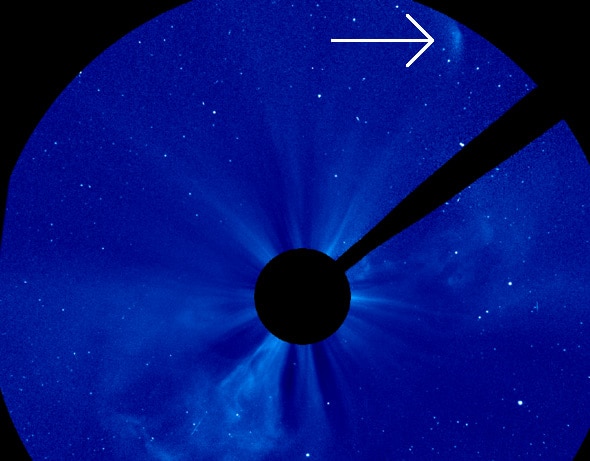Create a free profile to get unlimited access to exclusive videos, sweepstakes, and more!
Comet ISON Post Mortem

Or⦠âThat time I was right, then wrong, then probably right again like I was in the first place, more or less.â
The other day I wrote up a synopsis of the life and possible death of comet C/2012 S1 (ISON). Karl Battams, who runs the SungrazerComets Twitter feed and the Comet ISON Observing Campaign page, has an excellent summary of what we know so far (with a couple of very cool animations, too). The bottom line is that itâs been one surprise after another, with it getting bright, then dim, then bright again, then dim.
But, as we get more images of the comet as it heads away from the Sun, its ultimate fate is perhaps a little easier to see. The NASA / ESA spacecraft SOHO has been observing the comet since it entered its field of view on Nov. 28, and has told an interesting if somewhat head-scratchy tale. The solid nucleus of the comet started out about two kilometers wide, and got very bright. It faded rapidly as it approached the Sun, pretty much the opposite of what you might expect. But then it got bright again after it rounded the Sun, though not nearly as bright as before. And now it appears to be fading without stop.
Hereâs a video I put together showing the comet starting on Nov. 28 at 07:00 UTC (02:00 EST), and ending 44 hours later on Nov. 30 at 04:00 (Nov. 29 at 11:00 p.m. EST):
You can see the comet head was so bright at the beginning it was saturating the SOHO detector, but then faded fast (I wrote a brief explanation of what you see in SOHO images in an earlier post). The other thing to note is that now, days later, the comet has faded substantially; there is no nucleus to be seen, and we can even see stars right through the comet (the image at the top of this post was taken on Nov. 30 at 20:42 UTC, and makes that clear; ISON is on the upper right and is now pretty well dispersed).
So what happened? A video from a different viewpoint may help. The STEREO spacecraft are twin probes moving around the Sun in opposite directions. They are on the other side of the Sun from Earth, so they have a very different perspective on what happened. Here is a (low-res) video from STEREO A showing the same events:
At about 10-11 seconds in, as ISON is about to swing around, you can see it starts to emit a thin puff of something (it looks like a flash, a sudden thing, but I suspect that might be an illusion due to the comet happening to cross a bright region in the solar atmosphere, making the comet look brighter). This may possibly have been a disruptive event, breaking apart the nucleus. That would explain why it faded. Heating and expansion of the material would cause it to glow briefly, which would be why the comet brightened after perihelion, and then as it dispersed it would thin, so overall the comet would fade.
Mind you, the SDO and PROBA2 spacecraft did not see the comet; if a lot of ice were blown out they should have seen it. Also, at the end of the videos you see a cloud of material blow out and sweep around the comet; that is likely fine dust blown out by the solar wind. So it may be that the disruption event shook out a lot of dust, and what weâre seeing now is a big cloud of debris moving away. Maybe weâll know better when Hubble can take a look, but that wonât be for a few weeks (Hubble cannot look near the Sun, so we have to wait for orbital mechanics to bring the comet farther out). It may be there are still some decent sized chunks, and these could still brighten. I wouldnât get my hopes up though.
As Iâve said many times, though, there's a lot of stuff going on here, and itâs not at all clear what happened. Iâm guessing based on what Iâve seen, experts Iâve talked to, and my own experience observing comets.
And while I wonât make any firm predictions, because that path leads to ruin (or at least frustration), it does seem like this is the cometâs last gasp. The ethereal nature of the material in the SOHO images from Saturday makes it look like it wonât recover from this latest waning.
But who knows? When the comet started fading before perihelion I thought it might be dying, and I was more sure when it really smeared out. Then it came back, and we thought it survived, but now itâs looking more like that was a last gasp. This comet (and our estimation of what itâs doing) changes its story on an hourly basis, it seems.
So assume none of this is written in stone (or ice). We will certainly learn more as scientists analyze the data returned, and we get even more observations in the coming months.














